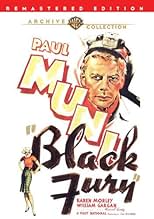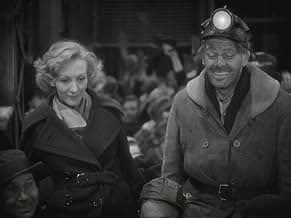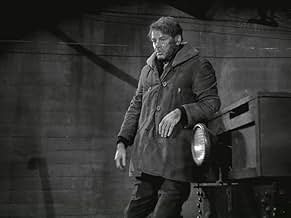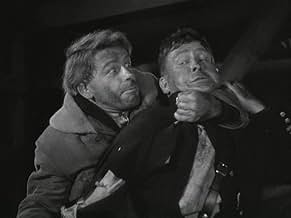IMDb RATING
6.4/10
1.1K
YOUR RATING
An immigrant coal miner finds himself in the middle of a bitter labor dispute between the workers and the mine owners.An immigrant coal miner finds himself in the middle of a bitter labor dispute between the workers and the mine owners.An immigrant coal miner finds himself in the middle of a bitter labor dispute between the workers and the mine owners.
- Nominated for 1 Oscar
- 2 wins & 2 nominations total
John Qualen
- Mike
- (as John T. Qualen)
J. Carrol Naish
- Steve
- (as J. Carroll Naish)
Joseph Crehan
- Farrell
- (as Joe Crehan)
Sara Haden
- Sophie Shemanski
- (as Sarah Haden)
G. Pat Collins
- Lefty - Company Policeman
- (as George Pat Collins)
Featured reviews
The fabulous Paul Muni gives another wonderful performance in this 1935 film.
With a genuine Slavic accent, Muni is superb as a coal miner who loses his girl (Karen Morley) to a company Policeman and goes on a drinking binge as a result. It is at this point that a gangster organization tries to create chaos within the union and Muni becomes their perfect foil.
J. Carrol Naish is excellent as the worker who works for this unholy organization.
Naturally, Muni's best friend is killed in a clash with company police and Muni, now sober, vows revenge.
Morley returns to Muni just in time as he goes down into the mine and starts blowing the place up. It's at this point that the film starts to go down, but with Muni's performance and the problems shown of what the coal miners had to endure plus the dishonesty in trying to break the union, all make for a very good film.
With a genuine Slavic accent, Muni is superb as a coal miner who loses his girl (Karen Morley) to a company Policeman and goes on a drinking binge as a result. It is at this point that a gangster organization tries to create chaos within the union and Muni becomes their perfect foil.
J. Carrol Naish is excellent as the worker who works for this unholy organization.
Naturally, Muni's best friend is killed in a clash with company police and Muni, now sober, vows revenge.
Morley returns to Muni just in time as he goes down into the mine and starts blowing the place up. It's at this point that the film starts to go down, but with Muni's performance and the problems shown of what the coal miners had to endure plus the dishonesty in trying to break the union, all make for a very good film.
Dynamic social conscience movie from the 1930's studio of record, Warner Bros.-- MGM may have had the glitz, but Warners had the heart. The film is no unmixed triumph. Muni over- acts, at times outrageously, yet most importantly there's no effort at prettifying the lives of the miners. The company shacks the miners must rent are unrelievedly dingy; the streets, narrow and drab; the women, unadorned in cheap house dresses. The only polish or comfort comes from company offices, but that too is understated. The underground sets look authentic-- closed-in, dirty and dangerous. No wonder the company keeps battalions of "cops" on hand. This "company town" is more like a penal colony than a work site, and I'm reminded of the old Tennessee Ernie Ford song "Sixteen Tons". Anyone thinking these conditions exaggerate should Google "Ludlow massacre" or "United Mine Workers of America" for historical insight.
The screenplay does a good job of weaving personal stories into the larger social context. At the same time, there are several topical points to note. First, there's a union-management agreement in place at the movie's outset. Neither side is fully happy, but work is proceeding (notice miners aren't paid for work not directly that of extracting coal!). Trouble is that strike-breaking companies like the one Croner (Naish) works for aren't making money during periods of labor calm. So, through Croner, they exploit lingering grievances to break the agreement, and make money. The screenplay casts them as the real villains, and not the union nor the company. Thus, the studio plays it safe by refusing to take sides between labor and management. And if miners are still unhappy, the script suggests conditions will continue to improve with the union behind them. Then too, once the various conflicts ( miners vs. strike-breakers; Radek {Muni}vs. Mc Gee {MacLane}) culminate, a federal government, depicted as justice-seeking, steps in to punish wrong-doers and guarantee the new agreement.
Thus, the government in Washington is cast in a non-partisan and positive light. At the same time, union and management are shown as able to reconcile their differences as long as there's no outside agitation. Now, this is in practical alignment with actual New Deal policy towards emergent industrial unions and newly installed federal bargaining rules (National Labor Relations Act). On the other hand, had the script wanted, Croner could have come from the political Left (Communist or socialist) instead of the political Right (strike- breakers). In historical fact, Roosevelt had to confront militant forces from both Left and Right in forging what became a Centrist labor policy that continued for decades. At the same time, the movie reflects much of that approach. Indeed, Warner Bros. was the New Deal's best friend in Hollywood as its many topical films from that period testify.
The movie does a good job of motivating the characters. The popular Radek becomes a vulnerable fall-guy for Croner once Anna (Morley) jilts him. Revealingly, both he and Anna are motivated by desires to escape the grueling life of the mines. Farm life may, in turn, be as burdensome, but at least you're your own boss. The very real problem of alcoholism is also hinted at in several scenes, it being the one escape open to the men. Note, however, that the screenplay remains vague on the demands of the break-away union faction, perhaps to keep the audience from taking sides over the strike. Something should also be said about that fine actress Karen Morley, a real-life labor activist in the actor's union. Her angular features bordered on prettiness, but were especially effective in registering icy determination, as a number of 30's films testify (e.g. Our Daily Bread, (1934).
Despite its many dated elements, the movie should not be looked at as a dead artifact. True, many of the awful work and living conditions depicted in the movie have since been overcome, thanks to labor's right to organize and bargain. Nonetheless, in our own time, many industrial jobs have been exported to low-wage countries, while coal as an energy source has been de-emphasized. Nonetheless, the basic conflicts between labor and management remain, whether blue-collar or white-collar, while government's role remains key. And in a sagging economy rife with unemployment and stagnant wages, old movies like Black Fury continue to resonate.
The screenplay does a good job of weaving personal stories into the larger social context. At the same time, there are several topical points to note. First, there's a union-management agreement in place at the movie's outset. Neither side is fully happy, but work is proceeding (notice miners aren't paid for work not directly that of extracting coal!). Trouble is that strike-breaking companies like the one Croner (Naish) works for aren't making money during periods of labor calm. So, through Croner, they exploit lingering grievances to break the agreement, and make money. The screenplay casts them as the real villains, and not the union nor the company. Thus, the studio plays it safe by refusing to take sides between labor and management. And if miners are still unhappy, the script suggests conditions will continue to improve with the union behind them. Then too, once the various conflicts ( miners vs. strike-breakers; Radek {Muni}vs. Mc Gee {MacLane}) culminate, a federal government, depicted as justice-seeking, steps in to punish wrong-doers and guarantee the new agreement.
Thus, the government in Washington is cast in a non-partisan and positive light. At the same time, union and management are shown as able to reconcile their differences as long as there's no outside agitation. Now, this is in practical alignment with actual New Deal policy towards emergent industrial unions and newly installed federal bargaining rules (National Labor Relations Act). On the other hand, had the script wanted, Croner could have come from the political Left (Communist or socialist) instead of the political Right (strike- breakers). In historical fact, Roosevelt had to confront militant forces from both Left and Right in forging what became a Centrist labor policy that continued for decades. At the same time, the movie reflects much of that approach. Indeed, Warner Bros. was the New Deal's best friend in Hollywood as its many topical films from that period testify.
The movie does a good job of motivating the characters. The popular Radek becomes a vulnerable fall-guy for Croner once Anna (Morley) jilts him. Revealingly, both he and Anna are motivated by desires to escape the grueling life of the mines. Farm life may, in turn, be as burdensome, but at least you're your own boss. The very real problem of alcoholism is also hinted at in several scenes, it being the one escape open to the men. Note, however, that the screenplay remains vague on the demands of the break-away union faction, perhaps to keep the audience from taking sides over the strike. Something should also be said about that fine actress Karen Morley, a real-life labor activist in the actor's union. Her angular features bordered on prettiness, but were especially effective in registering icy determination, as a number of 30's films testify (e.g. Our Daily Bread, (1934).
Despite its many dated elements, the movie should not be looked at as a dead artifact. True, many of the awful work and living conditions depicted in the movie have since been overcome, thanks to labor's right to organize and bargain. Nonetheless, in our own time, many industrial jobs have been exported to low-wage countries, while coal as an energy source has been de-emphasized. Nonetheless, the basic conflicts between labor and management remain, whether blue-collar or white-collar, while government's role remains key. And in a sagging economy rife with unemployment and stagnant wages, old movies like Black Fury continue to resonate.
Paul Muni was one of the most acclaimed and respected actors of his era...so much so that he nearly won the Oscar for Best Actor...as a write-in candidate! And, I must admit that when Muni is on, he's great. But occasionally I see a performance and wonder why it was so beloved...such as his over-the-top Eastern European-American, Joe Radek, in "Black Fury". Now I am not saying it's a bad film...just his performance.
As for the story, it's an interesting tale of both a union and management being manipulated into striking....and Joe is an unwitting dupe in the process. But, being a decent sort of guy at heart, he does what anyone would do in this situation...blow up the mine! Well, at least that's the crazy message you get in this picture!
Overall, an engaging and interesting film with many flaws...including its leading man's performance and the crazy vigilante message it promotes. A genuinely odd but entertaining picture.
As for the story, it's an interesting tale of both a union and management being manipulated into striking....and Joe is an unwitting dupe in the process. But, being a decent sort of guy at heart, he does what anyone would do in this situation...blow up the mine! Well, at least that's the crazy message you get in this picture!
Overall, an engaging and interesting film with many flaws...including its leading man's performance and the crazy vigilante message it promotes. A genuinely odd but entertaining picture.
"Black Fury" was the only time Paul Muni worked with Michael Curtiz. Potentially, this film could have been great but it is far from that. Muni wasn't very keen on acting in films, his preference was always going to be the theatre. He wasn't able to tone down his acting style for the cinema for the most part and he often appeared to be playing a caricature. He is guilty of this in the film "Black Fury." He is too theatrical in his facial expressions, his body language etc. Paul Muni plays a simple but honest coal miner who unwittingly becomes involved in a bitter dispute between the workers and the management. Muni, along with other miners, is subjected to intimidation. Barton MacLane is cast as a villain (he usually was) who is sent to destroy the livelihood of all the coal miners in this small community. Technically, the film is a disappointment. It is all too obvious that the sets representing the town in question are all on a soundstage. The sets don't look real and the direction from Michael Curtiz tends to suffer. The story itself is actually quite good and the film maintains a steady pace. The climax is also effective.
Paul Muni, David Thomson once wrote, was the '30s' idea of a great actor: He never looked the same twice. Here he's a hail-fellow-well-met Eastern European immigrant coal miner in a dreary Pennsylvania burg, deceived by union busters and weighed down by a ten-ton accent. Indeed the screenplay seldom rises above a fifth-grade literacy level, the better to illustrate the goodheartedness of these poor but honest laborers. But five minutes of Muni, and you've seen the whole performance -- a Zorba-the-miner "life force" who yells all his lines and sounds unfortunately like Steve Martin's wild-and-crazy-guy character from Saturday Night Live in the '70s.
Warners does come up with a convincingly grimy set and a capable stock-company supporting cast, but the dramaturgy is connect-the-dots. One miner shouts and sways the whole crowd, then another, then another -- what a gullible bunch this must be. The evil cops and management figures are so absurdly evil that nuance is lost. The third act does whip up to an exciting blow-up-the-mine climax, but then it's resolved in headline montages, as if Warners suddenly ran out of money, or film. And Michael Curtiz -- I didn't think this fine director was capable of this -- stages the crowd scenes clumsily, shifting point of view confusingly and slapping the mise-en-scene together hard, with loud music. Certainly the studio is on the side of the angels, arguing for a fair day's pay for a fair day's work, and as a '30s sociological curio the movie is not without interest. But Muni's monotonous bluster and an elementary script combine to create a cinematic cave-in.
Warners does come up with a convincingly grimy set and a capable stock-company supporting cast, but the dramaturgy is connect-the-dots. One miner shouts and sways the whole crowd, then another, then another -- what a gullible bunch this must be. The evil cops and management figures are so absurdly evil that nuance is lost. The third act does whip up to an exciting blow-up-the-mine climax, but then it's resolved in headline montages, as if Warners suddenly ran out of money, or film. And Michael Curtiz -- I didn't think this fine director was capable of this -- stages the crowd scenes clumsily, shifting point of view confusingly and slapping the mise-en-scene together hard, with loud music. Certainly the studio is on the side of the angels, arguing for a fair day's pay for a fair day's work, and as a '30s sociological curio the movie is not without interest. But Muni's monotonous bluster and an elementary script combine to create a cinematic cave-in.
Did you know
- TriviaThough it received no official Oscar nominations, the Academy permitted write-in candidates this year and when the voting order was announced it turned out that Paul Muni had come in second in the balloting, narrowly behind winner Victor McLaglen but ahead of any of the other nominated actors.
- GoofsAt c. 24 minutes Joe is counting out his money, but he is inconceivably inaccurate. After counting to 68 dollars he places two further bills on the table and counts "73" out loud. A few moments later he counts up to 75 dollars, but, after four more bills have been placed in front of him he announces "76" dollars as his total.
- ConnectionsFeatured in Hollywood and the Stars: The Angry Screen (1964)
- SoundtracksWhy Do I Dream Those Dreams?
(1934) (uncredited)
Music by Harry Warren
Played on piano in bar during scene where men challenge Radek
Details
- Release date
- Country of origin
- Language
- Also known as
- Black Fury
- Filming locations
- Warner Ranch, Calabasas, California, USA(mine shaft scenes)
- Production company
- See more company credits at IMDbPro
- Runtime1 hour 34 minutes
- Color
- Sound mix
- Aspect ratio
- 1.37 : 1
Contribute to this page
Suggest an edit or add missing content






































